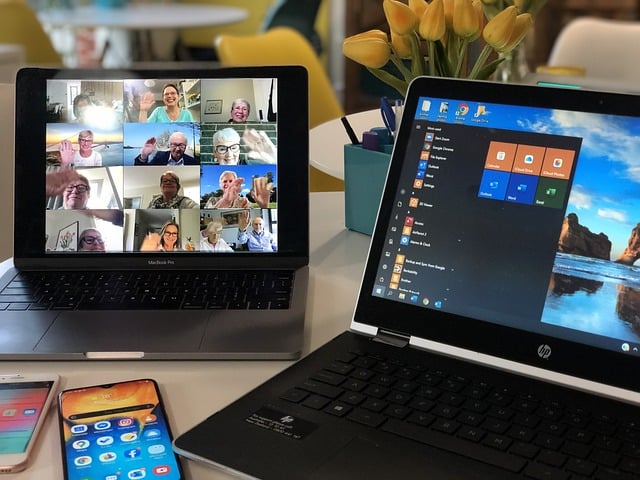10 Strategies for Maintaining a Remote Team in 2023

Ten years ago, if you told the CEOs of America’s most prominent businesses that one day their employees would work from the comforts of their homes, you would have become a laughingstock. But, here we are – in a world where the borders of proverbial “office space” has broken free of the brick-and-mortar building. Remote work, the practice of employees working in a space outside the traditional office, has grown from a rarity to commonplace – if not the norm, in some industries.
The catalyst for remote work’s growth is primarily attributed to the COVID-19 pandemic. The practice had started to grow beforehand, but when the world closed down to prevent the spread of the coronavirus, remote work offered a way for many industries to keep working. And surprisingly, remote work proved to be just as efficient, and in some cases more efficient, than working in the office.
Though the pandemic has waned, remote work has not. In fact, it continues to grow. Before the pandemic, Forbes magazine reported that only 4% of jobs offered remote work. That number has since exploded to 15% in late 2022. By 2023, researchers believe nearly a quarter of all American jobs will provide remote work opportunities to employees. It’s not a surprising change – among its many benefits, remote work can shrink the costs of owning brick-and-mortar office spaces, offer more flexibility to employees, and help with employee retention.
But remote work does come with its own unique challenges for team leaders and employees to work through. This article will explore common challenges for team leaders and members in remote work and offer solutions to address them – ensuring the team and its members thrive in the remote work environment.

I. Establishing Clear Communication Channels
It can not be emphasized enough that clear communication is critical to accuracy and efficiency. However, gathering an entire team together for an update meeting in remote work situations can prove challenging. However, supporters of remote work are quick to note that “water cooler” chats reduce drastically, and team members spend more time working than conversing in remote scenarios.
Chat programs like slack, company-wide emails and newsletters have become reliable and necessary tools for creating a cohesive communication system for remote workers. But unfortunately, remote communication styles come with an inherent dehumanization of communication. First and foremost, it’s easy to misinterpret the tone and content of written material without human body language and vocal inflection relaying the information.
Additionally, only using written communications fosters disconnect between communicators – it removes the parties’ ability to read each other’s facial expressions and body language to facilitate organic communication. Such practices risk creating a distant communication structure between team members. Studies by Berkley University indicate that remote workers collaborate less with each other and communicate asynchronously – meaning that communication can become constrained.
Best Practices for Managing Remote Communication Channels
While more independence and less chit chat can benefit a team or business, too much can make team members feel overworked and under supported. Therefore, best remote communication practices should incorporate video calls and meetings that “put a face to a name” and allow for more natural communication. Additionally, supervisors should go out of their way to “touch base” with team members in private emails – not every communication should be a BCC or CC situation. Such individualized contact builds a personalized relationship with each employee.

II. Setting Clear Goals and Expectations
A lack of clear expectations is one common complaint that runs in tandem with poor communication during remote work. Alongside maintaining a humanized communication relationship with employees, leadership should also seek to create clear goals and reasonable expectations for team members.
Establishing clear goals can help improve team efficiency and direct team members constructively. Team leaders should create clear guidelines on deadlines, responsibilities, and realistic individual goals for team members to follow. Clear goals allow team members to work collaboratively, building healthy dependency while also allowing each member to feel accomplished.
Best Practices for Managing a Remote Team’s Expectations
To best equip team members to reach goals, leadership should set regular virtual meetings to discuss and analyze the team’s progress towards goals. Additionally, team leaders should meet separately with each employee to establish individualized plans for each member. Finally, keeping regular updates on goals and milestones will foster a collaborative team environment.
Tips for Establish Goals
When establishing expectations for remote workers, it’s best to use measurable, tangible methods to track goals. Focus on goals measurable by metrics and deadlines. Define smaller parts of each project or goal and the expected deadline for its completion. Give team members a clear path of execution for every goal.

III. Encouraging Collaboration and Teamwork
Too often, remote work can feel like an island. Team members may feel cut off from their teammates, mainly when a team uses very little video communication. Encouraging collaboration and teamwork on goals and projects can bridge the technological gap between remote workers and foster positive communication and relationship development between team members.
Strategies and Best Practices for Encouraging Remote Collaboration
Fostering collaboration among team members begins with bringing the whole team together. In this instance, a team leader’s best tool will be video call technology. Leaders can use virtual team-building activities, collaborative projects, and “break the ice” style exercises to create a collaborative environment. Additionally, pairing team members on projects offers a chance for employees to work together to achieve assigned goals.
Team collaboration comes naturally, not through force. So offer frequent opportunities for team collaboration using a mix of work and relationship-focused activities. For example, give team members a chance to work together through “fun” activities like virtual trivia and collaborative games, assign team projects, and provide “chit-chat” time before meetings to keep collaboration and human interaction strong on the team. Or, to develop connections between members and offer encouragement, leadership can use recognition tools like Kazoo or Bonusly, where fellow employees can applaud or comment on a coworker’s performance. Many of these platforms also allow employees to collect points for prizes to incentivize their excellent work.
IV. Providing Regular Feedback and Performance Evaluation
In a typical office environment, team members receive feedback organically, often through a passing comment or impromptu meeting with their supervisor. Unfortunately, organic performance is challenging to come by in remote work.
By actively providing regular, scheduled, and unscheduled performance evaluations, team leaders keep employees abreast of their efficiency and success and show the employee their team leaders remain engaged and attentive to their team.
Strategies and Best Practices for Remote Feedback and Performance Evaluations
Like all communication during remote work, feedback evaluations should be a mix of written and video communications. Team leaders can email or chat with a quick comment on a job well done or suggestions for improvement. Still, performance evaluations should always involve video conferences to foster positive interaction between team members and supervisors. Video communications are particularly useful when establishing new goals and reviewing positive and negative performance aspects – it gives team members a more natural space to raise questions, concerns, and suggestions to their supervisors.

V. Establishing Trust and Building Relationships
Trust is essential to creating a healthy team dynamic capable of overcoming periods of increased workload and stress. Team leaders can find it challenging to establish trust with team members in remote work’s sometimes sterile and distant world. But it can be done.
Strategies and Best Practices for Establishing Trust and Building Relationships in a Remote Team
Trust comes with time, but many of the subjects previously addressed in this article can help foster it. For example, team activities and social hours give members a chance to get to know each other and their leadership. Clear communication and regular individual meetings show members that team leadership invests in team members. And actively taking the time to understand and support employees’ personal lives, goals, and motivations goes a long way to building a bridge of trust.
Team leadership should prioritize developing trust between themselves and the team as a whole immediately. The more trust team members have in leadership (and their other team members,) the better a team will function overall. Team leaders should focus on giving employees support to meet their goals while fostering enough independence to avoid micromanaging. Additionally, team leaders should fulfill their end of the relationship by guiding employees to meet their goals, offering growth opportunities, and giving honest performance evaluations.

VI. Emphasizing Work-Life Balance and Employee Wellbeing
Research indicates that overworking and increased stress have become unfortunate byproducts of poorly managed remote work. It’s imperative that leaders emphasize and promote work-life balance to support their employees. In doing so, management will also reduce burnout, increase employee retention, and foster a healthier work environment.
Best Practices and Strategies for Work-Life Balance in Remote Work
But how can an employer or manager encourage work-life balance when an employee’s home has become their office? Often, lines become blurred, with employees constantly feeling surrounded by work.
Ultimately, work-life balance is all about establishing healthy boundaries. Team leadership should take steps to reduce team communications during off-hours. Additionally, employees and leadership should stick to a schedule whenever possible – even for salaried workers.
Leadership can go a step further by encouraging team members to set physical boundaries at home. Managers can recommend employees work in a distinct, specific space during work hours separate from the rest of a home – say, an office or a specific spot in the dining room. And employers should encourage employees to step away from work throughout the day just as they would in-office. Team members should take breaks from the computer, eat an actual lunch, and take a walk break for mental and physical breaks from the workspace.

VII. Encouraging Professional Development and Training
In remote working situations, professional development and training can fall to the back burner, usually going hand in hand with a stagnant work environment and lack of communication. Investing time into offering employees professional development and enriching training serves two purposes: it educates and enhances the team and provides employees with encouragement and growth opportunities.
Strategies and Best Practices for Remote Team Professional Development and Training
As with all other aspects of managing a remote team, logistics can limit the types of opportunities leadership can offer employees. But, much of professional development can be managed via the collaboration and goal setting discussed previously.
Employers should not just offer professional development opportunities but actively discuss them with employees during one-on-ones. Outlining career goals, interests, and skillsets provides the roadmap to bringing appropriate and desired professional development to a team.
Additionally, it is wise to offer team development and training opportunities as well. Online conferences, for example, have created a unique space where employees and leadership can come together to learn from other professionals remotely.

VIII. Managing Time Zones and Cultural Differences
The era of remote work has broached a relatively new issue for many employers in managing time zones and cultural differences. After all, remote work allows employers to pursue prospective employees from around the world – the barrier of location has all but been eliminated.
Best Practices for Managing Time Zone Differences
However, creating a team with members from across the country – or across the world – is by no means an easy task. Critical to managing multiple time zones is a consistent organization and communication structure.
Leadership should keep careful note of team member time zones and work whenever possible to schedule meetings and communications at a time courteous to the employee and team in its entirety – without, of course, putting themselves in a significant disposition. Scheduling emails and recording meetings in case of scheduling conflicts are other useful steps to take when managing multiple time zones.
Strategies for Cultural Management of a Remote Team
Frequently, the multitude of time zones experienced in remote work also means building a team with members of different cultures. Acknowledging and understanding the various cultures represented in a team will go a long way to building a supportive environment for employees.
But how does a leader accomplish this? First and foremost, educate themselves on the cultural needs of their employees. Then, encourage team members to do the same. Understanding key phrases in a culture, gestures and body language will encourage positive communication relationships. Additionally, teams can take the time to do cultural spotlights or awareness training on the different cultures represented in the team.

IX. Ensuring Data Security and Confidentiality
Online security has become only more important as time has gone on. When remote work during the pandemic hit its peak, security concerns became heightened for many employers. Employees were no longer confined to the secure walls of an office building, with data and information at risk, from Human Resources to trademark information. Employers have had to rethink security and confidentiality.
Strategies and Best Practices for Data Security and Confidentiality
Keeping data secure in remote situations requires many of the same steps used in brick-and-mortar work setups. Employers should run frequent software updates, train employees to look for hacking attempts via training, require employees to use strong passwords, and insist on keeping work-related materials in a secure location or within sight at all times.
But, remote work situations require going the extra mile for enhanced security. Teams should utilize multi-factor authentication tools, VPNs, and password-protected meetings to reduce the risk of a data breach. Additionally, employees should be cautioned against using public wifi and should instead utilize a password-protected hotspot or home wifi.

X. Providing Adequate Tools and Resources
One significant barrier to overcome in remote work is the lack of physical resources for employees. There is no Human Resource office for them to visit; they can’t just knock on their supervisor’s door for a quick Q&A session. Thus, it’s critical that remote workers receive comprehensive tools and resources to ensure they feel supported, informed, and independent wherever possible.
Strategies and Best Practices for Providing Tools and Resources
True, remote employees don’t have a central office space housing resources and tools to support the job. But employers can create a central online space via an intranet or private employee website for employees that features Human Resource information, training guides, blogs, and other resources for employees.
Additionally, intranets can create a valuable space for connecting different departments, locations, and employees. Newsletters, open forum chats, and educational videos about other departments can give employees a deeper understanding of their fellow employees and create a more unified view of a company.
Conclusion
Managing a remote team can be challenging, but with the right resources and strategies, remote teams can function just as well – if not better- than traditional in-person ones. But like any management situation, leadership needs to employ several interconnecting strategies to find success.
Any team, whether remote or in-person, is an investment of a leader’s time and energy. Employers and team leaders can create a long-lasting remote team by developing and enforcing the ten strategies and pillars of remote work discussed in this article.
FAQs
• How can I ensure my remote team is productive?
Remote work puts considerable trust in a team member’s productivity. Ultimately, the best way to track a team’s production is to establish clear goals and milestones for the team and individual members to meet.
However, leadership can use specific tools to track team productivity if necessary. It’s important not to abuse these tools, or employees may feel micromanaged or untrusted. Tools like Clockify, Harvest, and Hubstaff can help leadership track an employee’s productivity. Alternatively, teams can use Google Docs and Excel Project sheets to work on and track project progress collaboratively.
• What tools are necessary for remote team management?
Remote work requires access to several types of team management tools, mainly those focusing on communication, security, and data storage. Teams should have access to a chat (Slack/Hangouts/etc.), company email, and an online meeting platform at minimum. Cloud storage for documents and projects, a VPN for security, and an intranet for information and resources are also key tools.
• What are the best practices for remote team communication?
It’s easy to go overboard with communication to remote teams when the only communication happens via online platforms. To avoid overburdening teams with excessive emails, chats, and meetings, streamline communications wherever possible. Send emails that are well-organized with bullets and hyperlinks, and only send them during designated working hours. Avoid using chats for official communications. Finally, use meetings for collaborative communication and organic team engagement as much as possible.
• How can I foster collaboration and teamwork in a remote team?
Teamwork makes the dream work, but achieving it remotely can seem like a nightmare. Above all else, you should strive to provide opportunities for teamwork – don’t expect it to just happen. It’s more difficult for employees to initiate collaboration remotely, particularly if they have never met teammates in person.
Additionally, take the time to have team members get to know each other through virtual ice-breaking activities, challenges in meetings, and social hours. The more teams develop relationships with one another, the more likely it is teamwork and collaboration will occur.
• How do I manage a remote team’s schedule?
Remote work often means managers are left navigating a multitude of different time zones and lifestyles among their employees. Most important to managing a team’s schedule is establishing critical times when all employees should be working, attending meetings, etc. This allows team members some flexibility in managing the rest of their time while giving leadership a cornerstone to build a team’s schedule.
Utilizing a scheduled service or time tracking app for employees are a few services leadership could consider investing in. Alternatively, teams can create a shared calendar indicating when they’ll be out of the office, when critical meetings are, when lunches are taken, etc., for easier schedule tracking.
Sources
- Global Workplace Analytics
- Owl Labs State of Remote Work Report
- World Health Organization – Coronavirus (COVID-19)
- McKinsey & Company – Remote work and the future of work
- Harvard Business Review – A Guide to Managing Your (Newly) Remote Workers
- Forbes – 7 Tips For Remote Work Success
- Buffer’s State of Remote Work Report
- American Psychological Association – Working Remotely During COVID-19
- Harvard Business Review – How to Manage a Team Across 5 Time Zones
- Forbes – How To Manage Cultural Differences In Remote Teams
- How to Build Remote Teams for Your PPC Agency
